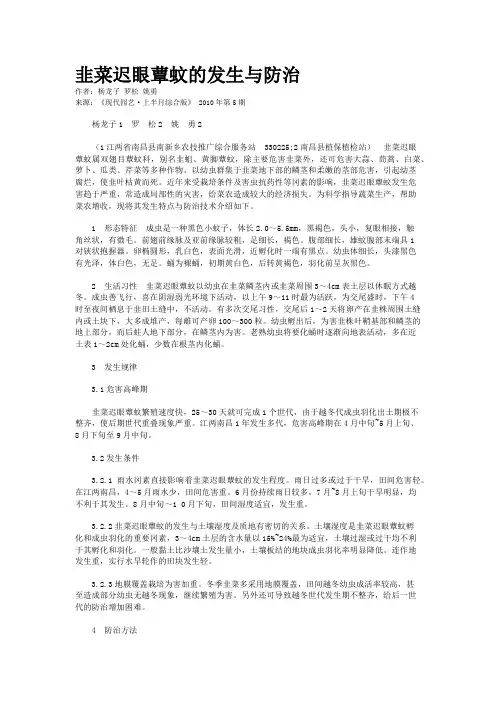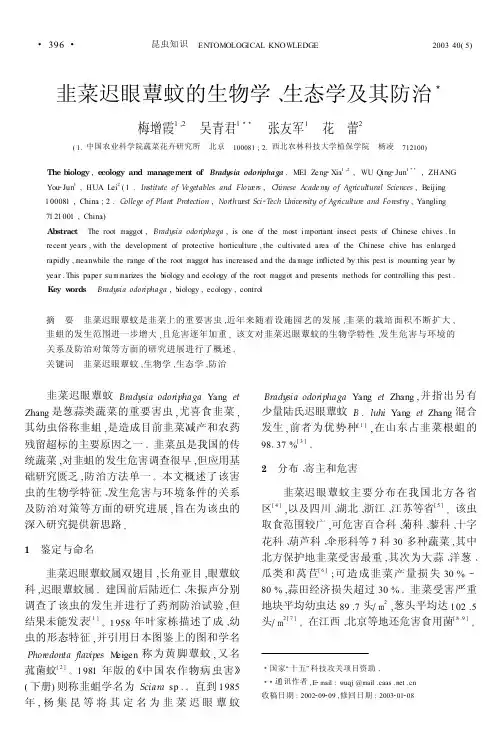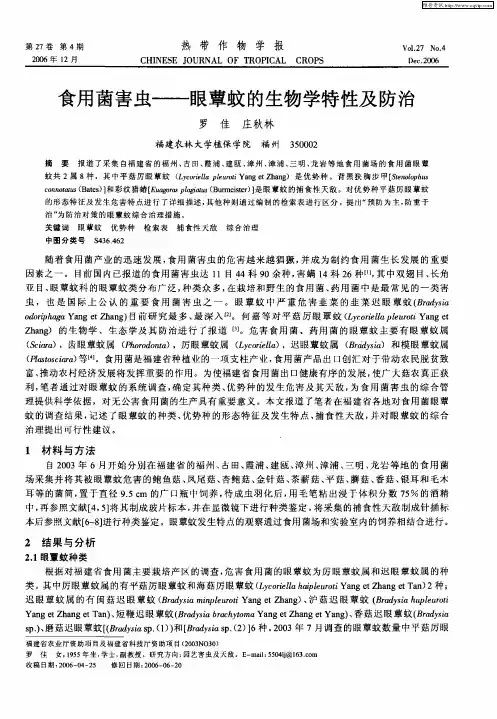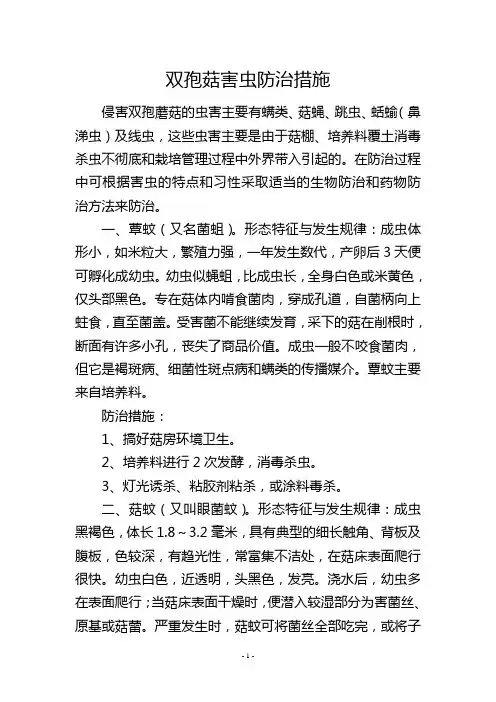蕈蚊生物学及其防治
- 格式:pdf
- 大小:74.67 KB
- 文档页数:2

韭菜迟眼蕈蚊的发生与防治作者:杨龙子罗松姚勇来源:《现代园艺·上半月综合版》 2010年第5期杨龙子1 罗松2 姚勇2(1江两省南昌县南新乡农技推广综合服务站 330225;2南昌县植保植检站)韭菜迟眼蕈蚊属双翅目蕈蚊科,别名韭蛆、黄脚蕈蚊,除主要危害韭菜外,还可危害大蒜、茼蒿、白菜、萝卜、瓜类、芹菜等多种作物。
以幼虫群集于韭菜地下部的鳞茎和柔嫩的茎部危害,引起幼茎腐烂,使韭叶枯黄而死。
近年来受栽培条件及害虫抗药性等冈素的影响,韭菜迟眼蕈蚊发生危害趋于严重,常造成局部性的灾害,给菜农造成较大的经济损失。
为科学指导蔬菜生产,帮助菜农增收,现将其发生特点与防治技术介绍如下。
1 形态特征成虫是一种黑色小蚊子,体长2.0~5.5mm,黑褐色,头小,复眼相接,触角丝状,有微毛。
前翅前缘脉及亚前缘脉较粗,足细长,褐色。
腹部细长,雄蚊腹部末端具1对铗状抱握器。
卵椭圆形,乳白色,表面光滑,近孵化时一端有黑点。
幼虫体细长,头漆黑色有光泽,体白色,无足。
蛹为裸蛹,初期黄白色,后转黄褐色,羽化前呈灰黑色。
2 生活习性韭菜迟眼蕈蚊以幼虫在韭菜鳞茎内或韭菜周围3~4cm表土层以休眠方式越冬。
成虫善飞行,喜在阴湿弱光环境下活动,以上午9~11时最为活跃,为交尾盛时,下午4时至夜间栖息于韭田土缝中,不活动。
有多次交尾习性,交尾后1~2天将卵产在韭株周围土缝内或土块下,大多成堆产,每雌可产卵100~300粒。
幼虫孵出后,为害韭株叶鞘基部和鳞茎的地上部分,而后蛀人地下部分,在鳞茎内为害。
老熟幼虫将要化蛹时逐渐向地表活动,多在近土表1~2cm处化蛹,少数在根茎内化蛹。
3 发生规律3.1危害高峰期韭菜迟眼蕈蚊繁殖速度快,25~30天就可完成1个世代,由于越冬代成虫羽化出土期极不整齐,使后期世代重叠现象严重。
江两南昌1年发生多代,危害高峰期在4月中旬~5月上旬、8月下旬至9月中旬。
3.2发生条件3.2.1雨水冈素直接影响着韭菜迟眼蕈蚊的发生程度。



沈阳农业大学硕士学位论文韭菜迟眼蕈蚊(Bradysia odoriphaga)生物学和生态学特性及其利用昆虫病原线虫防治的研究姓名:赵海燕申请学位级别:硕士专业:农业昆虫与害虫防治指导教师:丛斌20040601独创性声明本人声明所呈交的学位论文是在导师指导下进行的研究工作及取雩导的研究成聚。
据我所知,除了文中特别加以标注和致谢的地方外,论文中不包括其他入已经发表或撰写过麴研究成果,也不包括为获得其他教育机构的学位或证书而使用过的教材。
与我一嗣工作的同志对本研究所做的任何贡献均已在论文中作了嗡确的说瞬并表示谢意。
学位论文作者签名《螨热签字日期:如年年苦月tT-曰学位论文版权使用授权书本学位沦文作者完全了解避建蝣关保留,使用学位论文的规定,有权保留并向国家有关部门或机构送交论文的复印件和磁盘,允许论文被查阅和借阅。
本文授权可以将学位论文的全部或部分内容编入有关数据库进行检索,可以采用影印,缩印或扫描等复制手段保存,汇编学位论文。
(保密的学位沦文在解密后适用本授权书)学位论文作者签名;趣淘熬字目期:2∞趣年5月绺盟导师签名:乃训l签字日期:扣≯年6月f炉。
l1茂鬻采监犬学鞭圭学位论文摘要韭菜迟眼蕈蚊(Bradysiaodoriphaga)己发展成为韭菜的重要密虫,其幼虫俗称韭蛆,魁地下害虫,种群增长迅遮,抗药性强,单纯的化学防治不能有效建控割其为害,遥韬嚣簧掇强骏生物跨澹为主验缘含治理技术鹾究。
20蹩纪90年代以来,国内有关鼗蛆的研究集中在该虫发生规律、化学防治方法和窳内饲养方法等方面,对萁生物学、生态学等缺乏系统研究。
为此于2002年10月至2004年4舄t'B-J遴行了以下几个方面的研究。
l。
韭菜迟眼蕈姣在30℃、25℃、20℃、15℃秘lO℃的条幸掌下,由郛至成虫羽化的发育历期分别为14.33±1.76、15.00士O.58、20.oo±O.58、46.004-4。
73和69,OO±3.06d,其存活率分别为49.O%、73。


双孢菇害虫防治措施侵害双孢蘑菇的虫害主要有螨类、菇蝇、跳虫、蛞蝓(鼻涕虫)及线虫,这些虫害主要是由于菇棚、培养料覆土消毒杀虫不彻底和栽培管理过程中外界带入引起的。
在防治过程中可根据害虫的特点和习性采取适当的生物防治和药物防治方法来防治。
一、蕈蚊(又名菌蛆)。
形态特征与发生规律:成虫体形小,如米粒大,繁殖力强,一年发生数代,产卵后3天便可孵化成幼虫。
幼虫似蝇蛆,比成虫长,全身白色或米黄色,仅头部黑色。
专在菇体内啃食菌肉,穿成孔道,自菌柄向上蛀食,直至菌盖。
受害菌不能继续发育,采下的菇在削根时,断面有许多小孔,丧失了商品价值。
成虫一般不咬食菌肉,但它是褐斑病、细菌性斑点病和螨类的传播媒介。
覃蚊主要来自培养料。
防治措施:1、搞好菇房环境卫生。
2、培养料进行2次发酵,消毒杀虫。
3、灯光诱杀、粘胶剂粘杀,或涂料毒杀。
二、菇蚊(又叫眼菌蚊)。
形态特征与发生规律:成虫黑褐色,体长1.8~3.2毫米,具有典型的细长触角、背板及腹板,色较深,有趋光性,常富集不洁处,在菇床表面爬行很快。
幼虫白色,近透明,头黑色,发亮。
浇水后,幼虫多在表面爬行;当菇床表面干燥时,便潜入较湿部分为害菌丝、原基或菇蕾。
严重发生时,菇蚊可将菌丝全部吃完,或将子实体蛀成海绵状。
茄菇蚊,喜在未播种的堆肥中产卵,在播种后菌丝尚未长满培养料前孵化成幼虫,虫体长大时正是第一潮菇发生期,于是钻入菇柄和菌盖为害。
金翅菇蚊,为害小蘑菇,使之变成褐色革质状,在其爬过的床面留下闪光的黏液痕迹,虫口密度大的地方,幼菇发育受阻。
为害蘑菇的菇蚊有12种以上,其中茄菇蚊和金翅菇蚊发生较普遍。
防治措施:1、搞好菇房环境卫生。
2、菇房通气孔及人口装修纱门。
3、黑光灯诱杀,或在菇房灯光下放半脸盆0.1%的敌敌畏杀虫。
三、菇蝇。
形态特征与发生规律:成虫淡褐色或黑色,触角很短,比菇蚊健壮,善爬行,常在培养料表面迅速爬动。
虫卵产在培养料内的蘑菇菌丝索上。
幼虫为白色小蛆,头尖尾钝,吃菌丝,造成蘑菇减产。
晋南地区韭菜迟眼蕈蚊的发生特点及防治技术摘要介绍晋南地区韭菜迟眼蕈蚊的发生危害情况、形态特征,分析发生原因,并提出相应的防治措施,以为当地韭菜迟眼蕈蚊的防治提供参考。
关键词韭菜迟眼蕈蚊;形态特征;发生原因;防治措施;晋南地区迟眼蕈蚊(Bradysia odoriphaga Yang et Zhang),属双翅目眼蕈蚊科昆虫,别名黄脚蕈蚊、韭蛆。
在全国很多地区都有分布,主要分布在北京、山西、内蒙古、宁夏、台湾等地区,是葱蒜类蔬菜的主要害虫之一。
运城市盐湖区位于山西省最南端,光照充足,无霜期长,蔬菜是其农业发展、农民收入的重要产业支柱,无公害韭菜更是当地的优势产业。
但是,当地韭菜生产中多年重茬、连续耕作导致土壤自毒效应明显、土壤养分缺失、土壤板结,农民苗期除草不及时不科学,使得迟眼蕈蚊和葱须鳞蛾对韭菜危害十分严重,灰霉病大面积传播等,从而制约韭菜产品品质和产量[1]。
1 发生危害情况迟眼蕈蚊一直是运城市盐湖区韭菜田间的一种主要害虫,每年4—5月是幼虫和成虫防治的关键时期。
2014年4月20日在盐湖区王范乡刘村庄村进行抽样调查,发现一般地块虫株率20%~30%,严重地块高达70%~80%。
据观察,迟眼蕈蚊的幼虫主要为害韭菜地下部的鳞茎和柔嫩的茎部,咬破表皮,咬断新根,轻则植株细弱,形成黄条,使韭叶枯黄而死;重则鳞茎和顶芽被破坏而死亡,造成缺株断垄,降低韭菜的产量和品质,严重时鳞茎腐烂,整墩韭菜死亡,全田毁灭无收[2-4]。
在山西南部,迟眼蕈蚊一般每年发生4~6代,多以幼虫在韭菜鳞茎内或根附近的土壤中休眠过冬,第2年3月下旬开始化蛹,4月羽化为成虫,这个时期是全年防治的最关键时期。
5月上旬是第1代幼虫的危害盛期,以后1个多月发生1代,5月下旬至6月上旬第1代成虫羽化,成虫喜欢阴暗潮湿的环境,间歇扩散距离可以达到百米左右,甚为活跃,常栖息在韭菜根周围的土块缝隙间。
2 形态特征一是卵:椭圆形,长0.2~0.3 mm,白色,表面光滑。
蕈蚊防治方法蕈蚊是一种常见的害虫,对人类健康和农作物产量造成了严重的威胁。
为了有效防治蕈蚊,科学家和农业专家提出了一系列的防治方法,包括物理防治、化学防治和生物防治等。
本文将详细介绍这些防治方法的原理和操作步骤,以帮助读者更好地了解和应对蕈蚊的侵害。
一、物理防治方法1. 网罩覆盖:利用特制的网罩覆盖种植区域,阻止蕈蚊飞入,同时保证充足的阳光和通风。
这种方法适用于露天种植和大规模农田,可以大大减少蕈蚊的繁殖和传播。
2. 水果袋覆盖:针对果树上的蕈蚊,可以使用透明的水果袋将果实封闭,阻止蕈蚊飞入并产卵。
这种方法可以减少蕈蚊危害果实的数量,还能保护果实不受其他害虫侵害和疾病感染。
3. 洞穴灭蚊:蕈蚊常常在洞穴或地下隐蔽的地方繁殖,可以利用洞穴雾化器或喷雾器进行灭杀。
常用的灭蚊剂有菊酯类杀虫剂和氰戊菊酯等,注意使用时要遵守安全操作规程。
二、化学防治方法1. 杀虫剂喷洒:使用有效的杀虫剂经常性地喷洒在种植区域,特别是蕈蚊最活跃和繁殖的地方。
常用的杀虫剂有马拉硫磷、阿维菌素等,具体使用剂量和频率可以根据情况进行调整。
使用时要注意保护自己和环境,遵守使用说明和安全操作规程。
2. 熏蒸灭蚊:对于蕈蚊已经严重侵害的地区,可以进行熏蒸灭蚊。
常用的熏蒸剂有氨基甲酸习、红藻酸甲酯等,可以通过熏蒸器将药剂熏蒸到难以到达的地方,如洞穴或土壤中。
熏蒸时要注意保护自己的健康,避免接触和吸入药剂。
三、生物防治方法1. 天敌引入:找到蕈蚊的天敌,如蜇眼蛇、蜻蜓等,并进行大量引入种植区域。
这些天敌可以捕食蕈蚊和其幼虫,有效地控制蕈蚊的数量。
在引入天敌时要注意选择适应当地环境的品种,避免对生态环境造成其他不良影响。
2. 生物农药使用:利用一些对蕈蚊有特殊杀虫活性的微生物制剂进行防治。
例如,利用蘑菇霉、疫霉等微生物制剂进行喷洒,可以有效杀灭蕈蚊。
这种方法具有环境友好性,不会对非目标生物造成伤害。
总之,针对蕈蚊的防治方法多种多样,可以根据实际情况选择合适的方法进行防治。
Fungus Gnat Biology and ControlJ.P. SandersonFUNGUS GNATS:Identification:Adult fungus gnats (Bradysia spp.) aresmall (approx. 1/8 inch long), blackish-grey, gnat-like flies with long gangly legs,many-segmented antennae which arelonger than their heads, and have a singlepair of greyish transparent wings with a Y-shaped vein near each wing tip. [Fig.1]They are weak flyers and may be foundrunning/flying near soil level.Fungus gnat larvae are the damaging stage of thisinsect. They are usually concentrated in the top1-2 inches of the growing media, but can befound throughout the pot. The larvae aretranslucent, legless, and worm-like, with adistinctive black head capsule, and are about 1/4inch long just prior to pupation. [Fig.2] Larvaemight be seen crawling near the surface of thegrowing medium if the population is very high.Damage:The first few weeks of a crop are most critical for fungus gnat control. Larvae prefer to feed on fungi rather than healthy plant tissue. Although fungus gnat larvae can eat plant material, they need fungi in their diet for optimal survival, development, and reproduction.Chewing by larvae can cause direct root damage, andprovide an entry into the roots for fungal pathogens.Seedlings and young plants without fully developed rootsystems are particularly susceptible to their damage.[Fig.3]Unrooted cuttings are also particularly vulnerable, with larval feeding interfering with callus formation and thus root initiation. Adult fungus gnats do not cause direct damage to plants, but are considered a nuisance pest to consumers. In addition, adults and larvae have been implicated in the transmission of plant fungal diseases, including Thielaviopsis, Pythium, Verticillium, and Fusarium. Larvae may transmit fungal plant diseases via their excretion. Adults may transmit these diseases via excretion or by carrying spores of disease organisms on their bodies. Disease transmission by fungus gnats has been documented in lab studies, but it is not yet clear whether fungus gnats play an important role in disease transmission under commercial conditions.Biology: Mated adult females deposit up to 200 eggs singly or in clusters in crevices or cracks on the surface of the growing media. Adult females prefer to lay eggs where fungus is growing. The offspring of a given female will either be all males or all females. At 70° -75° F, these whitish-yellow eggs hatch in 3-6 days. The four larval instars then feed for about 2 weeks and usually pupate near the soil surface within a thread chamber. After 3-7 days in the pupal stage, adults emerge and live for up to 8 days. They can develop from egg to adult in 3-4 weeks. This life cycle is dependent on temperature and as temperatures decrease, the length of their developmental time increases. [Fig.4]Optimal temperature for development seems to be 70-75° F. They do not appear to thrive at high temperatures. Overlapping life stages are often present at the same time, though the bulk of the population may exist in only a few life stages.Monitoring: For monitoring adults, yellow sticky traps placed horizontally at soil level are most effective. However, fungus gnats can be monitored along with most other flying greenhouse pests by positioning yellow sticky traps vertically just above the crop canopy. Count them weekly and record the numbers to see if the infestation is increasing or decreasing. Because fungus gnats are often particularly damaging to young plants, monitor for adults several weeks before a crop is started, and continue to monitor as the infestation is cleaned up before the new crop is started. To monitor whether larval control is being achieved, use raw potato slices (at least 1 inch thick) or wedges, placed cut-side down on the surface of the growing medium. Check the slices weekly, replace them weekly, and record numbers of larvae found on the potato slices and on the soil surface beneath the slices.Cultural control: No growing mixes are immune to fungus gnat infestation, but fungus gnat numbers can vary among growing mixes. Adults are strongly attracted to microbial activity in soil/media. For fungus gnat management, avoid immature composts (<1yr old), including composted pine bark mix. Mixes with any compost are usually more attractive to fungus gnats than pure sphagnum peat. Good sanitation is vital. Clean up spilled growing media, clean up algae, and fix plumbing leaks. Weed control inside and outside the greenhouse is important. Avoid over-watering and sloppy irrigation. Keep compost piles well away from production areas. Cycle plants through the greenhouse as quickly as possible. Some growers have greatly reduced fungus gnat and shore fly adult levels by stretching strips of sticky yellow plastic 6” wide ribbon throughout the greenhouse near the soil level along the sides of benches or beneath benches, in areas of adult activity.Insecticides: Many insecticides used for fungus gnat control are insect growth regulators and only affect larval stages, not adults. May need both an adulticide and a larvicide for well-established populationsBiological control: Releases of natural enemies should be done when populations are low, at start of crop.Nematodes: Steinernema feltiae is the most effective nematode species for fungus gnat larvae. Make first application at planting, or soon after, then 2-3 weekly applications. Irrigate the day before application. Apply as a drench. Nematodes are not usually good at reducing a serious infestation, one reason why they should be applied near the start of the crop.Bacteria: Gnatrol is applied as soil drench. The active ingredient is a bacterium that must be ingested by fungus gnat larvae. The bacterial toxin that kills the fungus gnat larva is only effective for 48 hours after application; so repeat treatments with higher label rates at 3 to 5 day intervals for heavy infestations.Predators: Releases of the predaceous mite, Hypoaspis miles, may give excellent control. Release soon after planting. A single release has provided 6-8 weeks of control in some cases. The predators are capable of establishing and spreading throughout a greenhouse if the environment is favorable. They live in the top layer of soil and feed on any small arthropods they encounter (including thrips). Check each shipment for viability: shake up the bottle, then shake a small amount of sawdust carrier onto a sheet of paper and look for rapidly-moving light-brown mites, using a handlens. Not e: Th e info rmatio n give n here in is suppli ed wit h the unders tandin g that no di scrimi nation is in tended and n o endo rsemen t by C oopera tive E xtensi on is implie d. Co rnell Cooper ative Ext ension and i ts emp loyees assum e no l iabili ty for the e ffecti veness or re sults of any produ ct. C heck t he product l abel, which is the final word with r espect to pr oduct usage. It i s a vio lation of Fe deral law to use a produ ct in a mann er inc onsist ent wi th its label.。